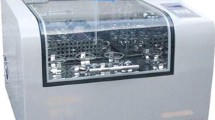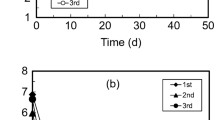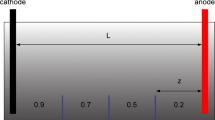Abstract
Anaerobic sediments of urban watercourses are subjected to industrial pollution and frequently tend to accumulate heavy metals. The biocatalyzed oxidation and reduction of sulphur compounds that occur within the sediment are key reactions that determine mobility of metals such as that occurred in mine acidic drainage reactions. The aim of this work was to study the application of these processes using heap leaching technology for the remediation of anaerobic contaminated sediments from Reconquista River basin. The bioleaching potentiality for remediation was demonstrated through batch tests in shake flasks with different pulp densities of anaerobic sediment containing 338 mg kg−1 of Zn and 117 mg kg−1 of Cu. Subsequently, bioleaching heap systems were compiled into columns of 12-cm height and 6-cm diameter, fitted with perlite to improve drainage. In order to assess the effect of elementary sulphur over the mobility of metals from the bioheap to the aqueous solution, increasing concentrations of elementary sulphur (1, 2, 5 % w/w) were added. After 3 months of acidification generated by periodic watering, the extraction of 70 % of the initial Zn and 43 % of the initial Cu was achieved. Polluted sediments from waterways as Reconquista River should not be indiscriminately manipulated if acid drainage is possible. Remediation by a simple and economically viable strategy like heap leaching is feasible.





Similar content being viewed by others
References
Akcil A et al (2015) A review of approaches and techniques used in aquatic contaminated sediments: metal removal and stabilization by chemical and biotechnological processes. J Clean Prod 86(1):24–36
Akinci G, Guven DE (2011) Bioleaching of heavy metals contaminated sediment by pure and mixed cultures of Acidithiobacillus spp. Desalination 268:221–226
Atkinson CA, Jolley DF, Simpson SL (2007) Effect of overlying water pH, dissolved oxygen, salinity and sediment disturbances on metal release and sequestration from metal contaminated marine sediments. Chemosphere 69:1428–1437
Caille N, Tiffreau C, Leyval C, Morel JL (2003) Solubility of metals in an anoxic sediment during prolonged aeration. Sci Total Environ 301:239–250
Calmano W, Hong J, Förstner U (1993) Binding and mobilisation of heavy metals in contaminated sediments affected by pH and redox potential. Water Sci Technol 28:223–235
Canadian Council of Ministers of Environment (2007) Environmental quality guidelines. Sediment quality index. Esdat Environmental Database Management Software.www.esdat.net. Accessed 25 Oct 2015
Cappuyns V, Swennen R (2011) Oxidation of anoxic soils and sediments: how can we evaluate the risk of heavy metal release? In: Ramsey G, McHugh S (eds.) River sediments pp 77–101
Cappuyns V, Swennen R, Deviver A (2006) Dredged river sediments: potential chemical time bombs? A case study. Water Air Soil Pollut 171:49–66
Castañé PM, Rovedatti MG, Topalián ML, Salibián A (2006) Spatial and temporal trends of physicochemical parameters in the water of the Reconquista River (Buenos Aires, Argentina). Environ Monit Assess 117:135–144
Charriau A et al (2011) Trace metal behavior in riverine sediments: role of organic matter and sulfides. Appl Goechem 26:80–90
Curutchet G, Gutierrez R, Grinberg S (2012) Degradación ambiental y periferia urbana: un estudio transdiciplinario sobre la contaminación en la región metropolitana de Buenos Aires. Ambiente & Sociedade 15:173–194 (in Spanish)
Defensoría del Pueblo de la Nación (2007) Informe especial de la cuenca del Río Reconquista: Primera parte. FOCO Web. http://www.foco.org.ar/documentos/informe_reconquista.pdf. Accessed 25 Mar 2014 (in Spanish)
Di Nanno MP, Curutchet G, Ratto S (2007) Anaerobic sediment potential acidification and metal release risk assessment by chemical characterization and batch resuspension experiments. J Soils Sediments 7:187–194
Di Nanno MP, Curutchet G, Ratto S (2009) S, Zn, Cr, Cu and Fe changes during fluvial sediments oxidation. Ciencias deI Suelo (Argentina) 27:199–207 (in Spanish)
Du Laing G, Rinklebe J, Vandecasteele B, Meers E, Tack FMG (2009) Trace metal behaviour in estuarine and riverine floodplain soils and sediments: a review. Sci Total Environ 407:972–985
Eggleton J, Thomas K (2004) A review of factors affecting the release and bioavailability of contaminants during sediment disturbance events. Environ Int 30:973–980
Fang D et al (2009) Effect of sulphur concentration on bioleaching of heavy metals from contaminated dredged sediments. Environ Technol 30:1241–1248
Fang D et al (2011) A combination of bioleaching and bioprecipitation for deep removal of contaminating metals from dredged sediment. J Hazard Mater 192:226–233
Förstner U (2004) Traceability of sediment analysis. Trends Anal Chem 23:217–236
Gadd GM (2010) Metals, minerals and microbes: geomicrobiology and bioremediation. Microbiology 156:609–643
Gelman F, Binstock R, Halicz L (2012) Application of the Walkley–Black titration for the organic carbon quantification in organic rich sedimentary rocks. Fuel 96:608–610
Johnson DB (2006) Biohydrometallurgy and the environment: intimate and important interplay. Hydrometallurgy 83:153–166
Kersten M, Förstner U (1991) Geochemical characterization of the potential trace metal mobility in cohesive sediments. Geo-Mar Lett 11:184–187
Lors C, Triffreau C, Laboudigue A (2004) Effects of bacterial activities on the release of heavy metals from contaminated dredged sediments. Chemosphere 56:619–630
Löser C, Zehnsdorf A, Görsch K, Seidel H (2006) Remediation of heavy metal polluted sediment in the solid bed: comparison of abiotic and microbial leaching. Chemosphere 65:9–16
Löser C, Zehnsdorf A, Hoffmann P, Seidel H (2007) Remediation of heavy metal polluted sediment by suspension and solid-bed leaching: estimate of metal removal efficiency. Chemosphere 66:1699–1705
Maddock J, Carvalho M, Santelli R, Machado W (2007) Contaminant metal behavior during re-suspension of sulphidic estuarine sediments. Water Air Soil Pollut 181:193–200
Materials Data, Inc. (2004) JADE version 7 software—XRD processing identification and quantification
Mellota MA (2015) Caracterización y estudio de procesos microbiológicos asociados a sedimentos del río Reconquista y afluentes. Dissertation, Universidad Nacional de San Martín, Argentina
Morse JW, Millero FJ, Cornwell JC, Richard D (1987) The chemistry of hydrogen sulphide and iron sulphide systems in natural waters. Earth Sci Rev 24:1–42
Peng J et al (2009) The remediation of heavy metals contaminated sediment. J Hazard Mater 161:633–640
Porzionato N, Mellota M, Candal R, Curutchet G (2013) Acid drainage and metal bioleaching by redox potential changes in heavy polluted fluvial sediments. Adv Mater Res 825:496–499
Porzionato N, Candal R, Curutchet G (2014) Biocatalyzed acidification and metal leaching processes in sediments of polluted urban streams. Int J Environ Health 7:3–14
Porzionato N, Mantiñan M, Bussi E, Grinberg S, Gutierrez R, Curutchet G (2015) Accumulation of pollutants, self-purification and impact of peripheral urban areas: a case study in shantytowns in Argentina. Int J Environ Ecol Geophys Eng 9:296–300
Quintana M, Curutchet G, Donati E (2001) Factors affecting the chromium(VI) reduction by microbial action. Biochem Eng J 9(1):11–15
Reisman DJ et al (2007) Statistical validation of sulfate quantification methods used for analysis of acid mine drainage. Talanta 71(1):303–311
Rohweder T, Sand W (2007) Mechanisms and biochemical fundamentals of bacterial metal sulfide oxidation. In: Donati ER, Sand W (eds) Microbial processing of metal sulfides pp 53–58
Seidel H, Löser C, Zehnsdorf A, Hoffmann P, Schmerold R (2004) Bioremediation process for sediments contaminated by heavy metals: feasibility study on a pilot scale. Environ Sci Technol 38:1582–1588
Seidel H, Wennrich R, Hoffmann P, Löser C (2006a) Effect of different types of elemental sulphur on bioleaching of heavy metals from contaminated sediments. Chemosphere 62:1444–1453
Seidel H, Görsch K, Schümichen A (2006b) Effect of oxygen limitation on solid-bed bioleaching of heavy metals from contaminated sediments. Chemosphere 65:102–109
Silverman MP, Lundgrem DG (1959) Studies in the chemo-autotrophic iron bacterium Ferrobacillus ferrooxidans: I. An improved medium harvesting procedures for securing high cell yields. J Bacteriol 77:642–651
Tabatabai MA (1982) Sulphur. In: Page AL, Tabatabai MA (eds) Methods of soil analysis, part 2. American Society of Agronomy Inc., Madison, pp 501–534
Teuchies J, Bervoets L, Cox T, Meire P, De Deckere E (2011) The effect of waste water treatment on river metal concentrations: removal or enrichment? J Soils Sediments 11:364–372
Ure AM, Quevauviller P, Montau H, Griepkin B (1993) Speciation of heavy metals in soil and sediments. An account of the improvement and harmonization of extraction techniques undertaken under the auspices of the BCR of the Commission of the European Communities. Int J Environ Anal Chem 51:135–151
Vera M, Schippers A, Sand W (2013) Progress in bioleaching: fundamentals and mechanisms of bacterial metal sulfide oxidation—part A. Appl Microbiol Biotechnol 97:7529–7541
Viera M, Curutchet G, Donati E (2003) A combined bacterial process for the reduction and inmobilization of chromium. Int Biodeterior Biodegrad 52:31–34
Watling HR (2014) Bioleaching of a low grade copper ore, linking leach chemistry and microbiology. Miner Eng 56:35.44
Yagnentkovsky N, Viera M, Donati E (2009) Recovery of nickel and zinc using biogenerated sulphuric acid. Adv Mater Res 71–71:649–652
Ye S, Laws EA, Gambrell R (2013) Trace element remobilization following the resuspension of sediments under controlled redox conditions: City Park Lake, Baton Rouge; LA. Appl Geochem 28:91–99
Zehnsdorf A, Seidel H, Hoffmann P, Schlenker U, Müller RA (2013) Conditioning of sediment polluted with heavy metals using plants as a preliminary stage of the bioremediation process: a large-scale study. J Soils Sediments 13:1106–1112
Acknowledgments
The authors acknowledge Consejo Nacional de Investigaciones Científicas y Técnicas and Fundación YPF (PIO13320130100203CO) and Universidad Nacional de San Martín (Diálogo entre las Ciencias) for the financial support. NP and AT acknowledge fellowship from CONICET. RC and GC are researchers of CONICET. They are also thankful to N. Morandeira for her contribution in the analyses of satellite data and edition of the image.
Author information
Authors and Affiliations
Corresponding author
Additional information
Responsible editor: Robert Duran
Electronic supplementary material
Below is the link to the electronic supplementary material.
ESM 1
(DOCX 1383 kb)
Rights and permissions
About this article
Cite this article
Porzionato, N., Tufo, A., Candal, R. et al. Metal bioleaching from anaerobic sediments from Reconquista River basin (Argentina) as a potential remediation strategy. Environ Sci Pollut Res 24, 25561–25570 (2017). https://doi.org/10.1007/s11356-016-6717-y
Received:
Accepted:
Published:
Issue Date:
DOI: https://doi.org/10.1007/s11356-016-6717-y




